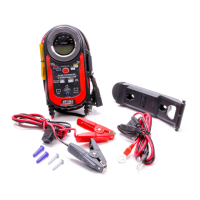109
Digital 40 0 Digital 40 0
Out of Vehicle Battery Charging Safety Precautions
22.FOLLOW THESE STEPS WHEN BATTERY IS OUTSIDE VEHICLE. A SPARK NEAR
BATTERY MAY CAUSE BATTERY EXPLOSION. TO REDUCE RISK OF A SPARK NEAR
A BATTERY:
CAUTION
a. Check polarity of battery posts. POSITIVE (POS, P, +) battery post usually has a larger
diameter than the NEGATIVE (NEG, N, -) post.
b. Attach at least a 60 cm 6-gauge (awg) insulated battery cable to a negative(NEG, N, –)
battery post.
c. Connect the RED POSITIVE (POS, P, +) cable clamp or ring terminal to the POSITIVE
(POS, P, +) post of battery.
d. Position yourself and free end of cable as far away from the battery as possible - then
connect the BLACK NEGATIVE (NEG, N, -) charger cable clamp or ring terminal to the
free end of cable.
e. Do not face battery directly when making final connection.
f. Connect charger AC supply cord to electric outlet.
g. When disconnecting charger, always do so in reverse sequence of connecting procedure
and break first connection while standing as far away from the battery as practical.
h. Plug charger into a properly grounded GFCI protected outlet.
j. A marine (boat) battery must be removed and charged on shore. To charge it on board
requires equipment specially designed for marine use.
Handling Batteries
WHEN HANDLING BATTERIES ALWAYS READ AND FOLLOW THE BATTERY MANUFACTURER
WARNINGS, INSTRUCTIONS AND CAUTIONARY MARKINGS.
DANGER OF EXPLODING BATTERIES
Batteries contain sulfuric acid and produce explosive mixtures of hydrogen and oxygen gas. Because
self-discharge action generates hydrogen gas even when the battery is not in operation, make sure
batteries are stored and are used in a well-ventilated area. ALWAYS wear ANSI Z87.1 (U.S. standard)
approved safety glasses and face shield or splash proof goggles when working on or near batteries:
Always wear proper eye, face and hand protection.
Never try to charge a visibly damaged battery.
Do not attempt to charge a frozen battery.
Have plenty of soap, water and baking soda nearby in case battery acid comes
in contact with skin, clothes or eyes.
Keep all sparks, flames and cigarettes away from the battery.
Keep removable vents tight and level except when servicing electrolyte.
Never try to open a battery with non-removable vents.
Make sure work area is very well ventilated.
Never lean over battery while boosting, testing or charging.
Exercise caution when working with metallic tools or conductors to prevent short
circuits and sparks.
Make sure that the charger leads to the battery are not broken, frayed or loose.
If the battery becomes hot, or if violent gassing or spewing of electrolyte occurs,
immediately turn off the charger and have your local dealer test your battery.
HANDLING BATTERY ACID
Battery acid, or electrolyte, is a solution of poisonous sulfuric acid and water that can destroy clothing
and burn the skin. Use extreme caution when handling electrolyte and keep an acid neutralizing solution-
such as baking soda or household ammonia mixed with water- readily available. When handling batteries:
Always wear proper eye, face and hand protection.
If the electrolyte is splashed into an eye, immediately force the eye open and flood it
with clean, cool water for at least 15 minutes. Get prompt medical attention.
If electrolyte is taken internally, drink large quantities of water or milk.
DO NOT induce vomiting. Get prompt medical attention.
Neutralize with baking soda any electrolyte that spills on a vehicle or in the work area.
After neutralizing, rinse contaminated area clean with water.
DANGER / POISON
SHIELD EYES
EXPLOSIVE GASES
CAN CAUSE BLINDNESS
OR INJURY
NO
SPARKS
FLAMES
SMOKING
SULFURIC ACID
CAN CAUSE
BLINDNESS OR
SEVERE BURNS
FLUSH EYES
IMMEDIATELY
WITH WATER
GET MEDICAL HELP FAST
KEEP OUT OF THE REACH OF CHILDREN. DO NOT TIP. KEEP VENT CAPS TIGHT AND LEVEL

